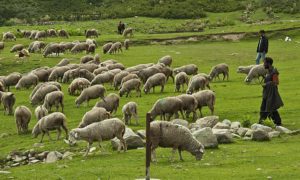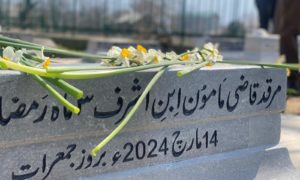“I know the amount of rice is not enough for a household, but one can’t do anything about it. We’re dispersing what the government gives us. It often leads to a quarrel with our customers.”
Shameema’s desperate outing this spring underlined another sweeping change in the valley. The young homemaker came out and joined angry women of her locality in the backdrop of the concerns created by rice reduction in the ration ghats of the valley.
At Mehjoor Nagar’s food depot, the homemaker made a human chain with others before raising a chorus: “Batte Daadi Maerikh Kaeshir Musalman, Hai Toofan Hai Toofan” (Kashmiri Muslims have been pushed to wall for ration).
“Not everyone can come on streets these days for their basic rights,” said Shameena with a somewhat hesitant body language. “But the ration reduction has affected everyone in Kashmir.”
People are feeling the heat of the ongoing rice crisis created by the Government of India’s decision to reduce Kashmir’s allotment quota. Some urban pockets even reported rage and ruckus over the new ruling. Apart from sardonic folksongs, the decision created angry scenes at many ration depots.
How it Started
The spark behind the simmer emerged in August 2022 when the government scrapped the Jammu Kashmir Food Entitlement Program aka Food Entitlement Scheme (JKFES). It changed the traditional monthly ration-procuring practice in the valley.
“I don’t know what to do with my ration card now,” said Saleem Khan, a Baramulla resident. “It has become another useless document just like my state subject.”
Before last summer’s edict, Kashmiris would get ample rice via ration ghats through multiple schemes. Among them was the National Food Security Act (NFSA).
Under this scheme, every BPL (Below Poverty Line) and PHH (Priority Household) ration cardholder would get 5 kilogram of rice per person at Rs. 3. Normal APL (Above Poverty Line) ration cardholders were receiving 5 kilogram rice per person at Rs. 15.
Then Came Covid
After the Covid-19 lockdown, the Government of India launched the Pradhan Mantri Garib Kalyan Anna Yojana (PMGKY). Under this scheme, the BPL, PHH and AAY consumers in Kashmir received free rations.
“This freebie was the beginning of the new order in the ration ghats of the valley,” said Mehjabeen Ali, a school teacher. “It changed the norm of ration distribution in Kashmir. We would receive a substantial amount of rice every month, but August 2022 changed that.”
Rise of Private Players
With ration ghats no longer selling sufficient food, many private rice stores have emerged across the valley. Most of them sell 30 kilogram of rice at the rate of Rs 900.
“The crisis situation is also a business opportunity for many,” said Rahim Bhat, a merchant in Maharaj Gunj. “You can see people stocking up rice in their shops these days. The fall of ration ghats has created a substantial demand for rice and activated the private market in Kashmir.”
A certain rice brand has already become a buzzword in the valley. The word-to-mouth in the crisis situation is itself hinting at the growing privatization in the valley.
“Traders always think according to market needs,” said Sameena Wahid, an economics scholar. “It’s quite clear that merchants are favouring the new order promising them growth.”
Back to Paddy
In the face of the new market matrix, many farmers are mulling to return to paddy cultivation. Most of the growers had shifted to orchard farming in the recent past, but the growing apple market and transportation concerns are encouraging many to go traditional.
“If at all some Kashmiri farmers are waking up to the reality and are shifting back to paddy cultivation, then it’s a smart market move,” said Arshid Kashani, a marketing manager. “We need to act as per the business demand and shun the redundant strategies costing us capital and time.”
Certain reports even suggest that land deals are already becoming reluctant, especially in the erstwhile farmlands where new housing colonies cropped up in recent years. The foot-dragging, it’s said, has been created by the renewed appetite for the Kashmiri rice.
“Many Kashmiris are likely to prefer local rice which they had spurned due to ration ghat supply,” said Ghulam Mohiuddin, a farmer in Ganderbal. “This demand will definitely slow down the land-selling process in the hinterlands. More and more people will go back to traditional farming to reap good market gains.”
Common Man’s Concern
Amid the sweeping change, Sahil Baba of Pulwama still falls in line in his native village for a freebie. “Government has turned us into beggars,” Sahil recalls a recent conversation at the ration ghat. “Working in paddy fields and producing our own rice was enough to feed us for more than two years.”
But now, the same people get into heated exchanges with storekeepers over the reduced ration.
“I know the amount of rice is not enough for a household,” says a storekeeper in Pulwama, “but one can’t do anything about it. We’re dispersing what the government gives us. Occasionally, it leads to a severe quarrel with our customers.”
Official Side
Officially, the ongoing crisis was created by the Government of India’s decision to increase unsustainable rates of Jammu and Kashmir Food Entitlement Scheme (JKFES) rice, said Abdul Salam Mir, Director of Food, Civil Supplies and Consumer Affairs (FCS&CA) Kashmir.
“We used to buy rice from the federal government for Rs 2400 per quintal and sell it to our customers for Rs 1500,” Mir says. “But now the government has raised the price to Rs 3500 per quintal. It’s entirely out of our pricing range. We’ve however outlined our demands in a proposal to the central government, and we anticipate this issue to be resolved quickly.”
As per the FCS&CA department records, the total number of JKFES ration received by the people of Kashmir was 76716.99 quintals in May 2022. The figure came down to 11500.00 quintals in June last year. The next month, in July 2022, these figures were 0.00.
Staple Stress
As the gradual ration reduction has created anguish in the valley, Shameema is still wondering about the collapse of the monthly support system.
“Rice is our staple food,” the homemaker says, “and making it scarce for people of Kashmir is downright cruel.”








